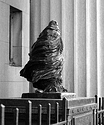Storage of Processed Prints
KODAK VISION Color Print Film / 2383/3383 has excellent image stability characteristics, very similar to 2386, 3386 Film. While prints are not usually intended as permanent records, Kodak recognizes the importance of good image stability. (Pre-print materials are the primary films intended for long-term storage, since new prints or video transfers can be made from them.) Even though most theatrical release prints spend a relatively short time in release before being deliberately destroyed, some prints find use in other markets, or are re-released years later. Museums and film archives usually do not have access to pre-print materials, so prints constitute the bulk of their collections.
Predictive dark-keeping image stability testing using the Arrhenius method (accelerated fading at high temperatures, extrapolated to predict the rate of fading at lower temperatures) shows that even after several decades of storage at room temperature and 50% relative humidity, properly processed prints made on 2383/3383 Film will show less than 10 percent image dye density loss. Of course, actual image and support stability depend upon the processing conditions, storage conditions, and other factors beyond the control of Kodak. Since color dyes may change over time, color films will not be replaced for, or otherwise warranted against, any change in color.
Store processed prints according to the recommendations in standard ANSI IT9.11-1992. SMPTE Recommended Practice RP 131-1994 also contains recommendations for proper film storage. For short-term "active" storage and projection (e.g., commercial film exchanges and theatres), room temperature of 20 to 25°C (68 to 77°F) at 50 to 60 percent relative humidity is recommended. Avoid prolonged unconditioned storage at high temperatures or excessive humidity. For medium-term storage, store at 10°C (50°F) or lower, at a relative humidity of 20 to 30 percent. For extended-term storage (for preservation of material having permanent value), store at 2°C (36°F) or lower, at a relative humidity of 20 to 30 percent. Enclosed long-term storage (i.e., sealed cans) will benefit by the use of Molecular Sieves in the storage container. Molecular Sieves are available from FPC (A Kodak Company), 6677 Santa Monica Boulevard, Hollywood, CA, 90038, Telephone (213) 468-5774.
Additional information on the proper storage and handling of processed film is contained in KODAK Publication No.H-23, The Book of Film Care .







